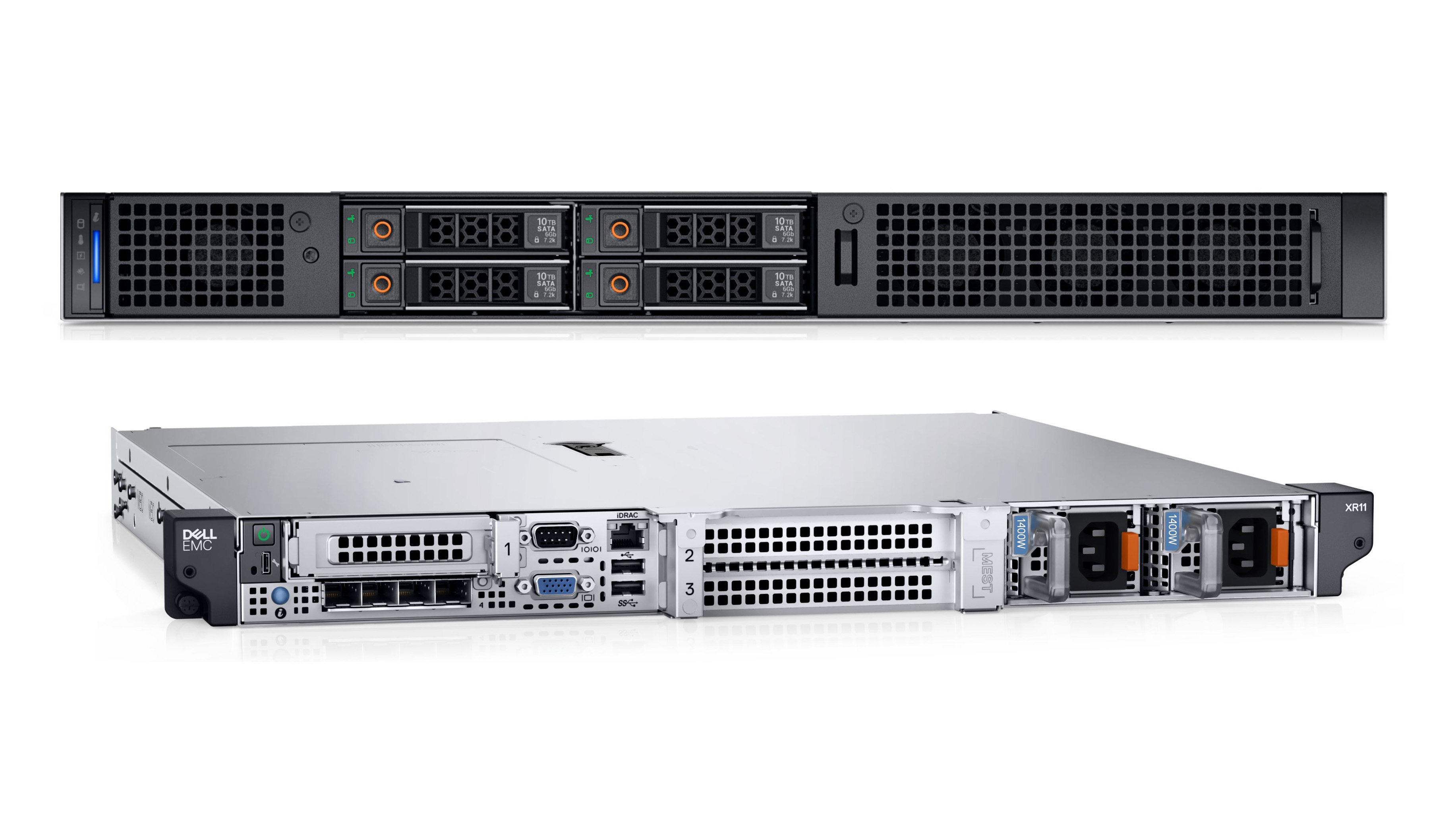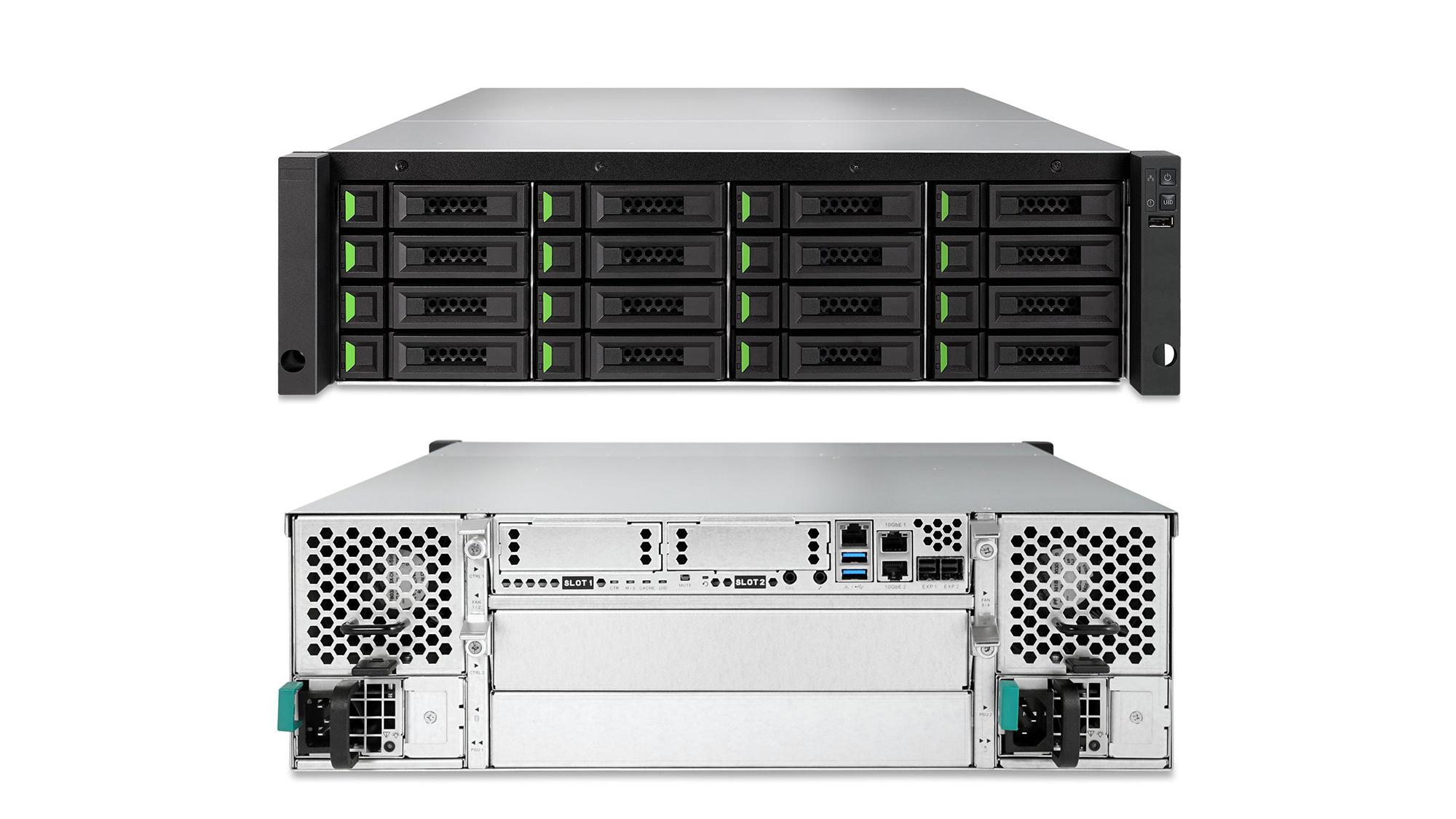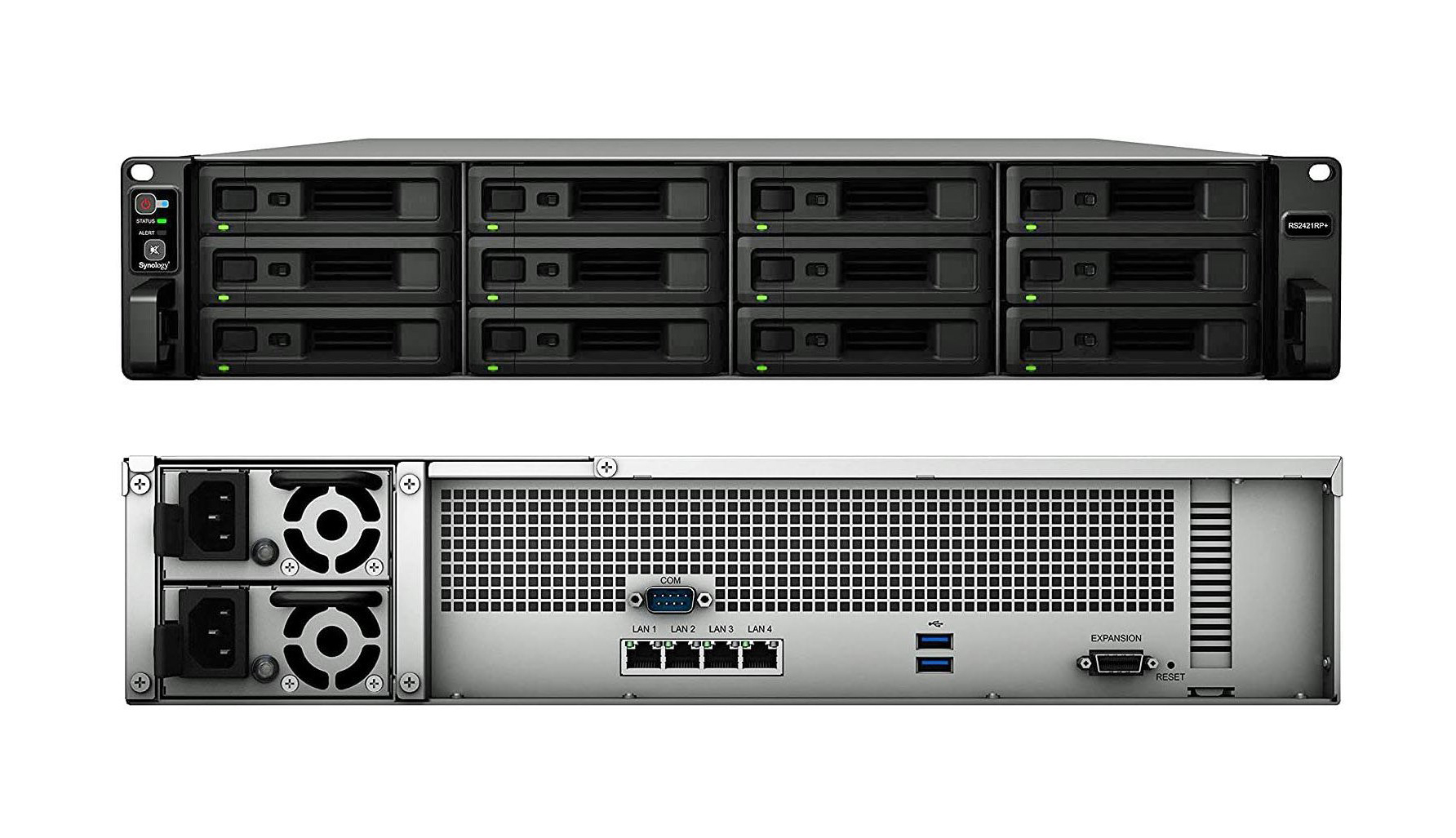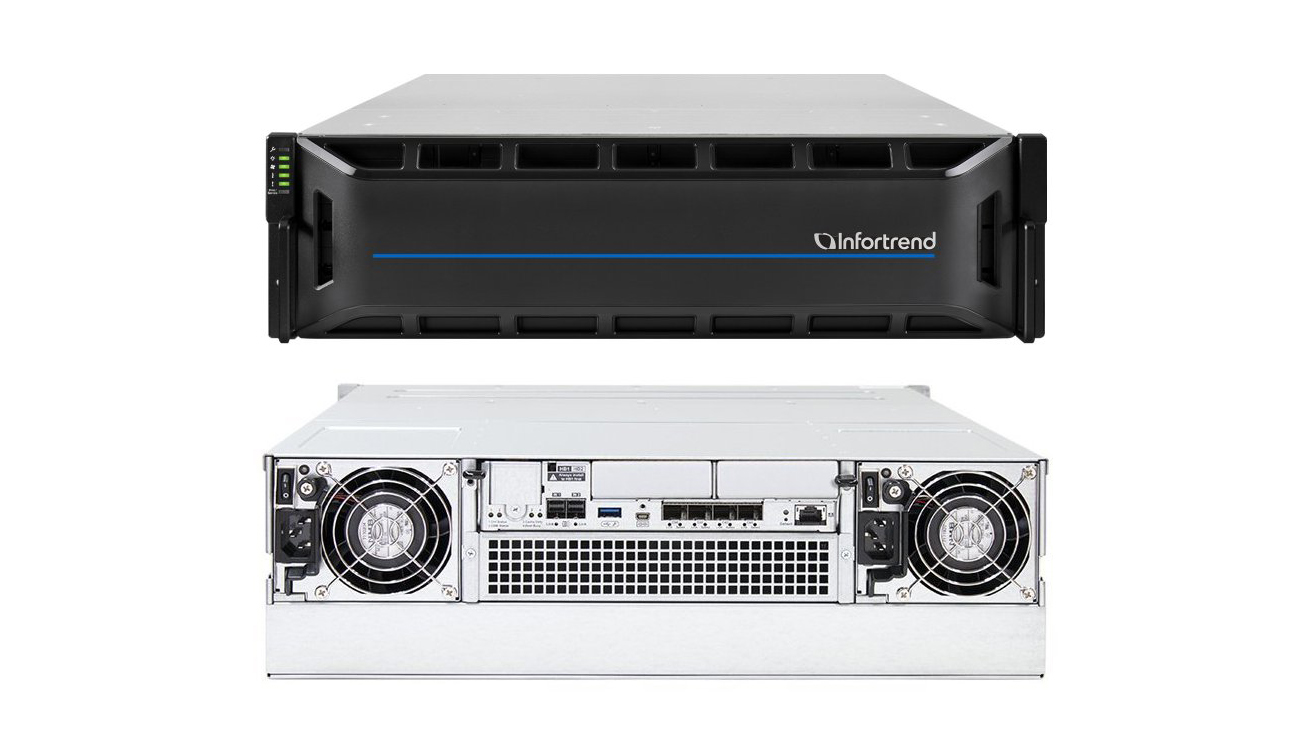Best rackmount NAS: Find the rack storage solution that’s right for you
Seeking out the best rackmount NAS for your business can unlock a range of long-term benefits - here are six of the best options available


Finding the best rackmount NAS is one surefire way to boost your business and open up a wealth of benefits and opportunities. Rackmount devices do a similar job as desktop storage boxes, but it is worth looking into if you already have a rack set up with servers, UTM gateways, or other appliances. They're a very convenient bit of kit.
And there is a lot of choice on the market. Thankfully, ITPro has tested the best of the best – along with those more budget-friendly models – to put together this business-friendly guide with all the advice you need for when purchasing a rackmount NAS.
What are the best rackmount NAS appliances in 2023?
Qsan XCubeSAN XS3312D
Our expert review:
Specifications
Reasons to buy
Reasons to avoid

The XCubeSAN XS3312D is another affordable SMB solution from Qsan with this 2U hybrid flash storage system supporting SAS3 HDDs and SSDs. That's in addition to dual controllers supporting combined IP SAN and FC SAN operations. The price is key, because all that is offered here, comes at a cost low enough to have most blue-chip providers green with envy.
That relatively low price comes with ample room up front for twelve storage devices, chassis with dual 850W hot-plug PSUs, and twin hot-plug fan modules. This is in addition to two controllers that run in active-active mode and provide total transparent failover. A combination that should yield a higher overall price.
Deployment is swift; the Qsan's XFinder app makes it easy to discover the array and provided direct access to its XEVO web interface. We found it very easy to use with the console's home page providing a status view comprising an overview of SSDs, pools, volumes and hosts, a pie chart showing storage and snapshot usage plus three real-time graphs for overall latency, IOPS and throughput.
During our review, we used the console's Storage tab to created two RAID5 pools each using an equal number of SSDs. This allowed the wizard to add a volume in each one. What's more you have a huge choice of RAID arrays as along with all the usual suspects, the XS3312D supports enhanced EE types which provide faster rebuild times by allowing more spare drives to be added to a pool.
When it came to performance, we ran Iometer on one server first which reported sequential read and write rates of 48.7Gbits/sec and 47.7Gbits/sec and random rates of 48.3Gbits/sec and 23.2Gbits/sec. We than swapped to Iometer 4KB blocks which returned random read and write I/O throughputs of 249,300 and 80,200 IOPS.
With both servers in the mix, we recorded impressive cumulative sequential read and write rates of 96.8Gbits/sec and 93.5Gbits/sec. Our read number equates to 12.1GB/sec which isn't far off Qsan's quoted maximum speed of 12.8GB/sec.
For a diskless unit, the MSRP is around £6,400, but it offers SMBs a top storage solution that can easily be expanded upon. Along with excellent FC performance, Qsan's XEVO OS offers a great set of easily managed storage provisioning and data protection features.
Price when reviewed: £6,400 exc VAT (MSRP, diskless)
Read our full Qsan XCubeSAN XS3312D review for more information.
Dell PowerEdge XR11
Our expert review:
Specifications
Reasons to buy
Reasons to avoid

Dell is a seasoned player when it comes to edge computing and its latest PowerEdge XR rugged servers are great at getting power out to it the places where data is being generated. The series comprises of the 2U XR12 and 1U XR11 single-socket models with both designed to operate in extreme environments. Indeed, the key point here is that the rugged XR11 can go where normal rack servers can't.
The package also includes support for a 36-core Gen 3 Xeon Scalable CPU, large memory capacity and high expansion potential which allows it to deliver plenty of power out to the edge to handle demanding apps. Although storage capacity could be seen as modest, its smart design allows it to handle SATA, SAS and NVMe devices, the quad-port 25GbE network LOM adds extra value and the XR11 benefits from the full range of Dell's remote monitoring and management services.
Price when reviewed: £10,638 exc VAT
Read our full Dell PowerEdge XR11 review for more information.
Qnap TS-h1886XU-RP
Specifications
Reasons to buy
Reasons to avoid

Qnap’s TS-h1886XU-RP crams a lot of expandability into its 2U chassis: like the TS-h1283XU-RP above, it offers 12 front-facing hot-swap drive bays, but also adds a further six SFF bays at the rear. That means you can install a huge amount of storage without having to rely on external shelves, or accelerate performance by adding an SSD cache of up to 4TB.
The TS-h1886XU-RP also lets you choose whether to use the user-friendly QTS platform or the more powerful – but more demanding – QuTS hero. Each offers a big library of installable apps to take care of data security and other functions, and while the quad-core Xeon D-1622 processor isn’t the most powerful in the range, it’s more than capable of running a whole stack of servers for a very fair price.
Price when reviewed: £2,756 exc VAT (diskless)
Read our full Qnap TS-h1886XU-RP review for more information.
Qsan XCubeNAS XN7016R
Best for SMBs focused on fast, expandable storage

Pros | Cons |
+ Huge maximum capacity | - Comparatively lightweight hardware |
+ Slick cloud integration | Row 2 - Cell 1 |
+ Speedy performance | Row 3 - Cell 1 |
An imposing 3U design allows this Qsan NAS to accommodate a generous 16 LFF drives. It’ll take both SATA and SAS3 media, and with external expansion it can serve up an immense eight petabytes. It’s a great performer too, delivering speeds of 9.2Gbits/sec over one of its twin embedded 10GbE ports.
Note that this isn’t a powerhouse like some other appliances: it uses a relatively modest Pentium D1517 CPU, and comes with a base 8GB of RAM. As with the XN8012S (see above) there’s also only a small selection of ten installable apps. Still, the core OS supports unlimited snapshots, deduplication and real-time data tiering – and your data can be easily replicated to a variety of cloud providers for offsite protection.
CPU | Quad-core 1.6GHz Intel Pentium D1517 |
RAM | 8GB ECC DDR4 (max 128GB) |
Drive bays | 16 x SAS3/SATA LFF/SFF |
RAID options | RAID0, 1, 5, 6, 10, Z3, JBOD |
Price when reviewed: £3,565 exc VAT (diskless)
Read our full Qsan XCubeNAS XN7016R review for more information.
Synology RackStation RS2421RP+
Best for smaller businesses seeking a user-friendly do-it-all NAS

Pros | Cons |
+ Powerful for the price | - No embedded 10GbE |
+ Very capable system software | - Restrictive list of supported drives |
+ PCI-E expansion slot | Row 3 - Cell 1 |
If you’re focused on value, the 12-bay RackStation RS2421RP+ demands serious consideration: its AMD Ryzen processor keeps the price low, while supporting all the features of Synology’s excellent DSM software. This means the appliance can happily take care of a whole slew of jobs, from regular file sharing to backup duties, virtualisation and even managing surveillance cameras – although for the best performance consider upgrading from the supplied 4GB of RAM to the maximum 32GB.
Be aware that Synology strongly encourages you to use its branded drives, rather than sourcing your own, but after installing these we had no complaints. The server delivered very competitive speeds for regular read and write operations, and is quick with encrypted storage too. For greater bandwidth, a PCI-E slot allows you to supplement the four integrated gigabit Ethernet ports with 10GbE or even 25GbE connectors.
CPU | Quad-core 2.2GHz AMD Ryzen V1500B |
RAM | 4GB ECC DDR4 (max 32GB) |
Drive bays | 12 x SATA LFF/SFF |
RAID options | RAID0, 1, 5, 6, 10, JBOD, SHR |
Price when reviewed: £1,822 exc VAT (diskless)
Read our full Synology RackStation RS2421RP+ review for more information.
Infortrend EonStor CS 3016G
Best for established businesses with an eye on growth

Pros | Cons |
+ Supports clustering for immense scalability | - Management console could be more intuitive |
+ Great connectivity options | Row 2 - Cell 1 |
+ No restrictions on supported drives | Row 3 - Cell 1 |
The EonStor CS 3016G is a 3U appliance whose front bays can take up to 16 SAS3 or SATA drives – but that’s by no means the limit to your storage options. Up to 144 units can be linked together for easy clustering, data replication and even erasure coding, to protect against large-scale data loss.
This naturally calls for a healthy chunk of connectivity, and the CS 3016G unit comes with four 10GbE SFP+ ports built in, along with twin expansion slots that can be used to add 25GbE or 40GbE connectors. It’s all powered by a trusty quad-core Xeon D-2123IT CPU and 64GB of RAM, which is battery-backed-up for extra stability. The price is high, but the EonStor CS 3016G is a fantastically scalable solution for businesses looking to grow and grow.
CPU | Quad-core 2.2GHz Intel Xeon D-2123IT |
RAM | 64GB DDR4 (max 256GB) |
Drive bays | 16 x SAS3/SATA LFF/SFF |
RAID options | RAID5, 5+hot spare, 6 |
Price when reviewed: £12,167 exc VAT (diskless)
Read our full Infortrend EonStor CS 3016G review for more information.
FAQs
Why does my business need a NAS appliance?
The purpose of a NAS drive is relatively simple; it's about providing storage that can't be accessed by users and services via the corporate network. You can assign private folders for each user, or set up shared drives across the whole business, with limited access to set groups.
This way, businesses can be certain all vital information is backed up, as opposed to all users having everything stored on their own hard drives – a failed device or a stolen one would then risk files being lost or falling into the wrong hands.
NAS drives also come with a host of advantages, especially when compared to cloud storage options. To begin with, it is significantly faster to access files on the local network than going through the process of uploading and downloading files to and from the cloud. Security is also aided by NAS, with administrators having full control over policies, upgrades, and backups when using a NAS drive.
Should I get NAS that runs apps
There are a number of NAS manufacturers that offer their own marketplace which one can install apps from, most of which offer extra functionality. For example, you can install a cloud synchronization module that seamlessly mirrors your data to an offset provider such as Google Drive or AWS.
If, however, there isn't an app store, that shouldn't be a dealbreaker; typically, the major platforms come with a fairly comprehensive set of built-in features, which generally meet all the fundamental requirements.
What's more, there are many apps that go beyond storage capabilities, ones that allow you to perform tasks like running web servers, managing CCTV systems, and even launching virtual machines directly to your NAS. However, ITPro recommends a cautious approach here, as these functionalities can significantly impact performance if your device lacks a robust CPU and ample RAM.
How many drive bays should I look for in a NAS appliance?
Make sure to remember it is important you use a RAID configuration in order to mirror your files across multiple disks and mitigate against the risk of permanently losing data in the event of a hardware failure. As a result, you will need more bays (and drives) than you probably realize. For example, four 8TB drives doesn’t equate to 32TB of usable space: in fact, you would get 18TB if you configure the drives a RAID 1 array, or 24TB with RAID 5.
It's good to have plenty of bays anyway; this allows you to easily expand your storage by adding more drives in the future. However, many appliances can be connected to external drive enclosures, so you can connect more disks to your NAS and manage them as if they were internal.
Just keep an eye on the size: some bays only take 2.5in drives – also known as small-form-factor, or SFF – while regular 3.5in drives require large-form-factor (LFF) bays.
What sort of network connection do I need for a NAS appliance?
The most lightweight NAS models have one or two gigabit Ethernet ports; that’s fine if only a few people need access, but if dozens of users want to share and browse files at the same time, they’re liable to run into bandwidth bottlenecks. That’s especially the case if there are backup tasks running in the background, or other services running on the NAS.
Most business-class appliances therefore come with two or more 10GbE connectors. This should be ample for a mid-sized office; larger companies should consider looking for a model that can be upgraded with a 25GbE or 40GbE expansion card. Of course, this isn’t a one-stop upgrade: you’ll need to connect your NAS to a gateway or switch that’s able to take advantage of these huge speeds.
Sign up today and you will receive a free copy of our Future Focus 2025 report - the leading guidance on AI, cybersecurity and other IT challenges as per 700+ senior executives
Darien began his IT career in the 1990s as a systems engineer, later becoming an IT project manager. His formative experiences included upgrading a major multinational from token-ring networking to Ethernet, and migrating a travelling sales force from Windows 3.1 to Windows 95.
He subsequently spent some years acting as a one-man IT department for a small publishing company, before moving into journalism himself. He is now a regular contributor to IT Pro, specialising in networking and security, and serves as associate editor of PC Pro magazine with particular responsibility for business reviews and features.
You can email Darien at darien@pcpro.co.uk, or follow him on Twitter at @dariengs.


